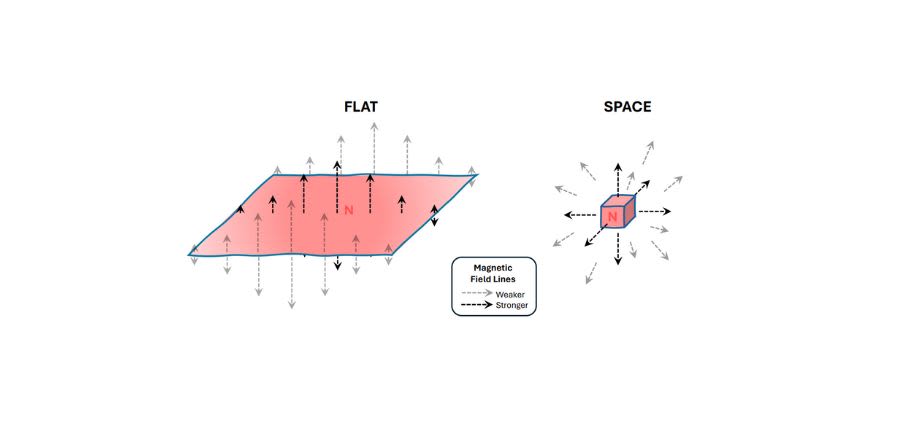Rustland – a tale of flat magnetism
While fundamental magnetic monopoles remain elusive, Cavendish scientists have managed to create emergent magnetic monopoles in flakes of rust, with potential applications for faster and greener computing

It is common knowledge that a magnet comes with two poles, north and south. Cut the magnet in half, and you get two smaller magnets, each still with two poles. This is a widely held notion taught to us in school, yet there is no reason why a magnet with a single pole, known as a monopole, could not exist. Theoretical speculation about monopoles began with Paul Dirac’s quantum theory of magnetic charges in 1931, in which he showed that if at least one magnetic monopole exists in the universe, then electric charge must be come in discrete lumps – in other words, electric charge must be quantised. Well, electric charge is indeed quantised, hinting that monopoles may actually exist. But despite extensive searches, including at particle physics experiments like the Large Hadron Collider, we have yet to find conclusive evidence of magnetic monopoles as fundamental particles in our universe.
The arrangement of spins in a 2D plane that give rise to an emergent monopole.
The arrangement of spins in a 2D plane that give rise to an emergent monopole.
Monopoles as emergent quasi-particles
Instead of searching for a single elusive fundamental particle, our team in Cambridge pursued the intriguing concept of monopoles as a collective phenomenon in a system composed of many atomic magnets. In the study published in Nature Materials, these tiny magnets, also known as spins, arranged in a particular pattern on a plane shown in the illustration to the right, can exhibit characteristics akin to a magnetic monopole. This is a fascinating example of 'emergence', a concept popularised by Philip Anderson in his seminal essay More is different. Emergence suggests that the collective behaviour of a system can give rise to entirely new properties that are more than the sum of its individual parts. In this case, the spins collectively form what can be described as a quasi-particle resembling a monopole. Indeed, with different spin distributions, we can obtain a zoo of exotic magnetic quasi-particles, including one resembling an anti-monopole.
Flat magnetism
An interesting consequence of the physical picture above, is that the emergent magnetic charges are two-dimensional – or flat. One can visualise this using the magnetic field generated by the charges. For a true monopole in isolation, the magnetic field lines extend outwards from the particle in all directions. For emergent monopole charges, the field lines extend only in directions perpendicular to the plane hosting them. The emergent magnetic charges are therefore restricted to a two-dimensional plane and exhibit two-dimensional magnetic character.
For a 2D monopole, the magnetic field lines only extend perpendicular to the plane (left), whereas they would extend in all directions for a fundamental monopole (right)
For a 2D monopole, the magnetic field lines only extend perpendicular to the plane (left), whereas they would extend in all directions for a fundamental monopole (right)
Direct visualisation via quantum sensing
Despite their intriguing nature, such monopole-like quasi-particles are difficult to observe directly due to their extremely weak magnetic field signature. In the new study, our team employed a new cutting-edge imaging technique, harnessing the extremely high magnetic field sensitivity of a single, isolated spin embedded within a sharp diamond tip. This approach involves scanning the diamond tip across a magnetic sample of interest, allowing researchers to reconstruct the underlying magnetic properties. This is equivalent to using a tiny bar magnet to sense a large distribution of bar magnets.
Fertile rustland
While using this diamond quantum sensor to study a tiny crystal flake of hematite, a reddish rust compound commonly found in rocks and soil, we were surprised to detect a monopole field signature amongst the other predicted quasi-particles. We found that these magnetic charge patterns, arising from the intricate interplay of whirling spins, are remarkably stable even in the ambient conditions of the lab. They were spontaneously created as the hematite sample was warmed up from just under minus three degrees Celsius to room temperature. The experimentally obtained spin and magnetic charge distribution are shown alongside their theoretical models in the figure below.
Comparison between the theoretically predicted and experimentally measured spin and magnetic charge distributions.
Comparison between the theoretically predicted and experimentally measured spin and magnetic charge distributions.
Opening doors to new paradigms
It has been suggested that magnetic charge (or spin) quasi-particles can glide across the material surface to easily encode and process information. This breakthrough study therefore marks a significant step towards greener and faster computing, as the visualisation of magnetic monopole quasi-particles not only makes them easier to study, but also opens exciting avenues for their precise control and manipulation. Fundamentally, the monopolar and other charge patterns observed in hematite are two-dimensional – like a pancake of magnetic charges – and are very unlike the point-like nature of a true magnetic monopole living in a three-dimensional space. They are, in fact, constituents of a complex charge ensemble, interacting with each other on a two-dimensional charge canvas, and could provide invaluable insights into monopolelike properties in a controlled physical dimension that is dissimilar to ours. True monopoles might still be elusive, but in the meantime, we can have fun studying their 2D equivalent, much alike going to a gallery to stand in front of an exotic landscape, that for now at least, exists only as a painted canvas.
Anthony K. C. Tan completed his PhD at the Cavendish in 2022, supervised by Mete Atatüre and has now taken up a postdoctoral position at Imperial College London.


